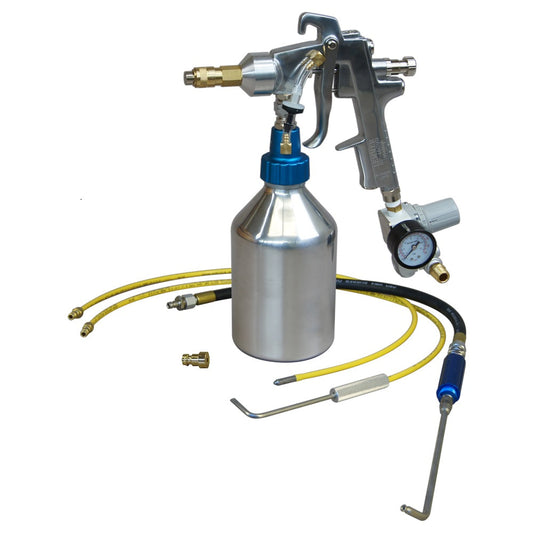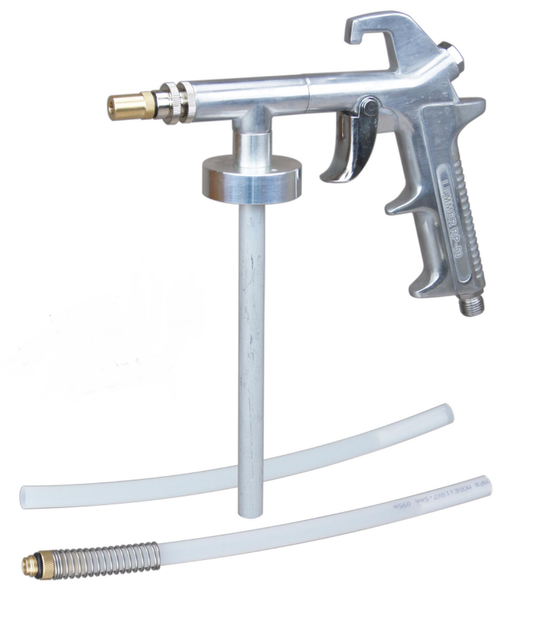
How to reseal your RV roof
Most RVs require a bit of maintenance, especially the roof and exterior walls. Water intrusion is probably the biggest enemy for an RV, as it causes extensive damage, causing you to need to replace the flooring in your RV, or walls and ceiling and sometimes the fixtures. If water gets into the roof, walls, or floors, the repairs are always extensive and expensive. Most people don't realize they have a problem until there is serious wood rot, meaning the leak has been leaking for quite some time.
You can also end up with Mold issues from the water damage, further complicating repairs.
However, all that can be avoided with consistent, regular maintenance. Keeping your roof sealed is part of that maintenance. Using good products can greatly improve your results and reduce the amount of problems in the future.
Why should you clean you RV roof regularly?
Cleaning your RV roof should be done at least a couple of times a year. This can greatly reduce the amount of black streaks that you'll need to clean on the exterior walls and also helps keep your roof in good shape. It's also a great time to do an inspection for any leaks, or other issues.
How to easily clean your RV roof?
Why does the roof start to leak?
RV's use a few different types of materials for roofing; Rubber or poly membranes, Aluminum and fiberglass, with the membranes being the most common, by far. These types of roofs will develop leaks from age, usage & changing temperatures which cause the sealants to crack and degrade. Storm damage, hail and falling branches are another common cause of damage to the membranes. Aluminum and fiberglass generally only get leaks if something strikes them hard enough to penetrate.
We'll cover a number of methods to re-seal and/or replace your roof; Some of them are simple DIY fixes which can be done in an hour or two, while others may take multiple days. Still others may need professional installation over several days.
First, you must determine which type of roof you have, then where any leaks are, or pre-emptively seal any potential leaks.
How to inspect your roof?
Visual is the first method, which involves getting up on the roof to look for obvious signs and even some that might be less obvious. If you're new to this, having an experienced person to help you is a good idea. Look for cracks, holes, impact points, tears, degradation or other damage to the roof, sealants, joints, previous repairs, or even the vents, AC units, or other items that protrude thru the roof.
Another method is using FLIR Thermal Imaging inspections, looking for water damage. This is a great non-invasive way to inspect your RV and look for signs of leaks and water damage. A FLIR (Forward Looking InfraRed) thermal camera is used to detect heat signatures of objects. In an RV, it can show cold spots in walls, ceilings and other areas, which is a great way to at least show you where to look for leaks and also where any water may have traveled inside the walls etc., causing insulation and wall materials to get wet. This requires specialized camera equipment, so you'll need a technician with this equipment to do it for you, or you'll need to purchase it. Basic systems can be had for a few hundred dollars.
How often should I reseal my RV roof?
With a conventional EPDM or TPO roof, at minimum, you should inspect your roof at least 2-3 times a year and touch-up/reseal it at least once a year. However, this is subject to several factors; recent storms, local weather temperature fluctuations, where and how you store your unit, is your RV stationary at a site, or is mobile?, among other factors. If there was a recent bad storm with lots of large hail and downed branches, an inspection should be done as soon as possible.
With aluminum, fiberglass and Flex-armor roofs, there is more durability, so probably just regular inspections are needed, or after a really bad storm.
Generally it is best to remove old sealants before applying new ones. These can usually be removed with a plastic paint scraper, or a putty knife or gasket scraper. However, you need to be very careful not to catch the roof membrane when scraping with metal tools, as you can easily tear it. Rounding of the corners of the knife or scraper can help with this.
Caulking type (non-sag) and/or self leveling Caulk(lap sealant)
These types of products are generally used along the edges of the membrane and anywhere that a facility item protrudes thru the roof, such as a vent stack, AC unit and so on. Lap sealants generally need to be inspected and replaced on a regular basis- ie. every 5-10 years for replacement, but sometimes more often.
This video shows how to remove and replace lap sealant.
Liquid rubber or similar - There are several versions of this sold by different companies, such as Liquid rubber, Rexoseal, Armor Poxy and others. This is a rubberized product that bonds directly to your membrane roof, after the prescribed prep work and primers. Ideally, you'll cover the whole roof with it in one project. It can be a good DIY project for anyone with average skills/ability, but it will take a few days to do it all. Cost isn't crazy expensive, as most mid-to-large RVs can be done for under $1000, if you DIY. If you need to contract the work, it will cost more. Sample 'How-to' video
Silicone coatings - Some of these are similar to the 'Liquid Rubber' style products, in how they are used and applied.
Acrylic coatings - These are applied in roughly similar fashion to the Rubber and Silicone products. However, these are usually water-based and don't tend to hold up as well as the silicone products. If you have issues with ponding water on your roof, the acrylics should be avoided, as they tend to break down under standing water.
Tapes (Eternabond, Proflex etc.)
These tapes are very durable, flexible tapes with very high bonding power and thermal stability. They will bond to EPDM, TPO, Hypalon, Aluminum, Fiberglass, Wood and Galvanized steel.They are typically used to repair tears in roof membranes. However, they can also be used in place of Caulks/lapsealants along roof edges and around objects that protrude thru the roof.
The surfaces need to be very thoroughly cleaned and dry before using. The tape needs to be firmly pressed or rolled into place, as that activates the bonding agents. Here's a How-to video
These tapes can last a lot longer than lap sealants, so can be a very valid option.
These are perfect for both small fixes, such as a simple hole in the membrane, or also for much larger jobs.
Permanent Roof Coatings
Flex Armor/Invincible RV Roof/Armor Thane, etc.- These are unique urethane based spray-on products that completely seals the whole RV roof. They're installed in specialized service shops with specialized installation equipment & techniques. They provide a heavy duty coating that is maintenance free and can handle storms, hail, falling branches and more. They're designed to last decades and come with a lifetime warranty, which is transferrable. Although it does cost several thousand dollars, it can be a very good solution to prevent water intrusion & save a lot of worry & repair efforts. It's also cheaper than a membrane roof replacement.
RV Armor - This is another specialized product that permanently seals the entire roof and is maintenance free with a long life. It's installed by a specialized team that comes to your location. Installation is weather dependent and you may have a longer wait time because of that. It also has a lifetime transferrable warranty.
Hybrid polyureas - Linex/Rhino etc. Similar to the other spray-on products, these also require professional installers with specialized equipment and a significant amount of prep work. They offer a permanent, durable, maintenance-free roof solution.
DIY/Contractor/Costs
Rubber roof replacement EPDM, TPO
These types of roof systems are the most popular from the manufacturers, because they are reasonably durable lightweight, stretchy, quiet and flexible. However, they do need consistent maintenance and repair. When they need to be replaced, it usually costs many thousands of dollars, as it takes many hours and there often needs to be repairs done to the underlayment and sometimes even the structure. If you are handy, this can be a DIY job, which will save you thousands of $$$. Replacement membranes and sealants can usually be bought for a few hundred dollars, for the average sized trailer.
These systems have a typical lifetime of about 10 yrs or so.
Aluminum - As anyone with an Airstream can tell you, Aluminum is very durable as a roofing system, yet is still reasonably light. Although it is susceptible to dents, it can last many decades without worry of leaks or punctures. Only in the worst cases will it get punctured. If that happens, it is still quite easy to repair, at least to temporarily stop water intrusion, until a more permanent repair can be done.
Aluminum can also be used to patch, replace, or cover an existing membrane roof. Typically you would have a skilled tech to install this.
Fiberglass roofs - These are also fairly durable, but can still get damaged from storms and falling branches. They are also subject to UV damage which causes oxidation and chalking on the surface of the gelcoat.
Fiberglass surfaces should be cleaned and waxed regularly to protect against UV degradation. They are easy to repair with a simple DIY fiberglass kit, which can be bought at any hardware or automotive retailer. However, basic DIY repairs should be kept to the roof, or other areas out of plain sight, as they can be quite obvious and unsightly. The biggest issue is getting the gelcoat repaired properly so that the repair is un-noticeable. To repair fiberglass and coloured gelcoats and make the repairs seamless, it takes special materials, skills, process and equipment, shown in this video. For most, it can be best to call in a pro.
RV Storage-
How you store your RV can have a very noticeable impact on how much maintenance and repair your RV will need. It can greatly extend the life of your roof and seals and greatly reduce maintenance and repair.
If you can store it inside and out of the elements, that will greatly improve how well each sealant/coating holds up & will greatly improve how long a roof membrane lasts. This is especially good if you can lay a tarp just over the roof while it's stored indoors, to protect from birds etc. This is depending on how the storage facility is setup.
If you store outdoors, some people use an RV cover which can protect the surfaces from UV etc. However there is some debate that covers can create other problems, such as trapping moisture.
You will need to be conscious of the moisture issue when storing an RV, as it is very hard on the frame/chassis, as well as the interior. (see pic below) You also need to be aware of mice and other rodents
Rusted RV frame from moisture:
Hopefully this has given you some good information and direction on keeping your RV roof sealed and improving the enjoyment of your RV.
None of our Blog posts are written with AI. All our blog posts are fully written by a real person, sharing real world knowledge and expertise.
Keywords
Dicor
Dicor RV sealant
RV roof sealant
RV roof repair
Camper roof sealant
RV sealant roof
Roof sealant for RV
Motorhome roof repairs
Eternabond
Proflex
Rexoseal
Tropicool
Lippert Acrylic
Sikaflex
Liquid Rubber
Flex armor
RV Armor
Linex RV roof
Rhino Lining RV roof
BlackJack
Silicone RV roof coating
Flex Seal
EPDM roof





